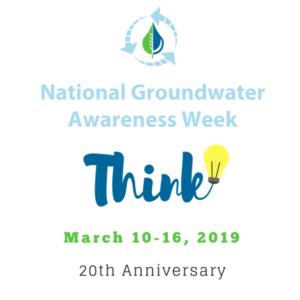
Today until March 16, 2019, the National Ground Water Association and organizations around the country observe National Groundwater Awareness Week (GWAW).
During this week the Marion County Wellfield Education will participate and bring you information, fun videos, and ideas to highlight responsible development, management, and use of groundwater.
This year’s theme, Think, was designed to urge each of us to consider various ways we can protect our most valuable natural resource. Let’s start with busting some myths!
Biggest groundwater myths
- Groundwater removed from the Earth is never returned.
- Fact: when groundwater is taken up by plants, it evaporates into the air and can return as rain. Or, if the groundwater opens into a surface body of water, it could also be absorbed back into the ground. (View 5 minute animated video on groundwater and the water cycle).
- Groundwater is not a significant source of water supply.
- Fact: Only 1% of water on the earth is usable, 99% of which is groundwater! Additionally, at any given moment, groundwater is 20 to 30 times greater than the amount in all the lakes, streams, and rivers of the United States.
- Groundwater is abundantly available, therefore does not need to be conserved.
- Fact: In arid and semiarid regions, the rate of groundwater pumping can be higher than the rate of replenishment, resulting in serious problems of groundwater mining. Adequate time is needed to allow replenishment of underlying groundwater reservoirs (aquifers); also such areas must be properly managed in order to prevent water-soluble waste products stored in these areas from infiltrating and polluting the underground supply.
- There is no relationship between groundwater and surface water.
- Fact: In large part, the flow in a stream represents water that has flowed from the ground into the stream channel. Conversely, water can be absorbed from any body of water back into the ground.
- Groundwater moves rapidly.
- Fact: Groundwater normally moves slowly through spaces between particles of earth or rock. Rates are measured in feet per day, month or year (can be as slow as 1 foot per decade!), whereas rates in rivers and streams are measured in feet per second or hour.
Compiled from the National Groundwater Association – Groundwater Facts
Read some of our articles from previous weeks under the #GWAW and stay tuned in the next few days!
